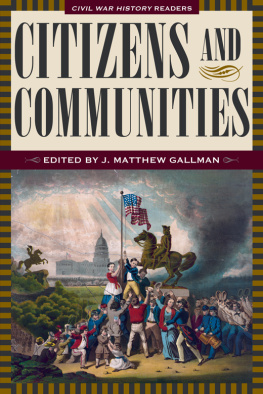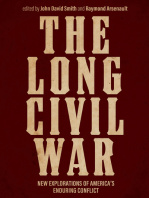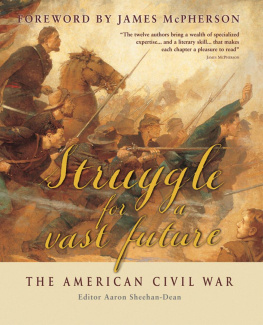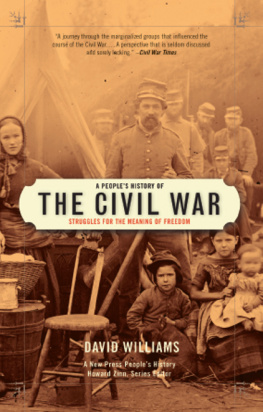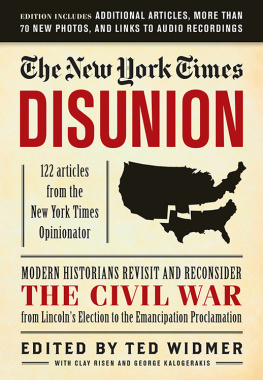
Citizens and Communities
CIVIL WAR HISTORY READERS
Since 1955 the journal Civil War History has presented the best original scholarship in the study of Americas greatest trial. In commemoration of the wars sesquicentennial, The Kent State University Press presents Civil War History Readers, a multivolume series reintroducing the most influential articles published in the journal.
| Conflict and Command | Edited by John T. Hubbell |
| Race and Recruitment | Edited by John David Smith |
| On Lincoln | Edited by John T. Hubbell |
| Citizens and Communities | Edited by J. Matthew Gallman |
CIVIL WAR HISTORY READERS
VOLUME 4
CITIZENS
AND
COMMUNITIES
Edited by
J. MATTHEW GALLMAN
THE KENT STATE UNIVERSITY PRESS
Kent, Ohio
2015 by The Kent State University Press, Kent, Ohio 44242
All rights reserved
Library of Congress Catalog Card Number 2015009653
ISBN 978-1-60635-247-2
Manufactured in the United States of America
LIBRARY OF CONGRESS CATALOGING-IN-PUBLICATION DATA
Citizens and communities / edited by J. Matthew Gallman.
4 volumes ; cm. (Civil war history readers ; volume 4)
Includes bibliographical references and index.
ISBN 978-1-60635-247-2 (pbk. : alk. paper)
1. United StatesHistoryCivil War, 18611865Social aspects. 2. Confederate States of AmericaHistorySocial aspects. I. Gallman, J. Matthew (James Matthew) II. Civil war history.
E468.9.C47 2015
973.71dc23
2015009653
19 18 17 16 15 5 4 3 2 1

Contents

For just over sixty years, Civil War History (CWH) has stood as one of the best places to find top scholarship on the middle period in American history. Moreover, as John T. HubbellCWHs editor for a miraculous thirty-five yearsexplained in the first volume of this retrospective series, the journal was founded, at least in part to enlist the academy into the mission of describing the Civil War to the public. A journey through six decades of the quarterly journal, spanning over nine hundred scholarly articles, is a marvelous tour of both the evolving trends in academia and, perhaps, in the interests of that broader reading public.
I am pleased to have been invited to edit the Civil War History Bookshelfs volume on the home front. As expected, the task of selecting just sixteen essays proved formidable. Home front is a term that allows for multiple definitions. Often home front scholarship, a close cousin to social history, is defined by what it is not. The term generally refers to scholarship that is not military history, political history, economic history, or diplomatic history. Sometimes that scholarship asks how the Civil War affected civilians who stayed behind. Other work focuses specifically on the contributions of noncombatants to the war effort; thus, the folks at home are seen as presenting another front to the conflict. Much home front scholarship integrates many themes into a single narrative, often focusing on a particular community.
Sixty years of Civil War History are particularly interesting in this context, since the home front only emerged as a coherent field of inquiry in the early 1980s, or roughly halfway through the life of the journal (up to now). A glance at six decades of the journal reveals considerable attention to home front themes, A half century later, the contents of Civil War History had changed considerably. The essays are longer and generally more theoretical. New questions and scholarly perspectives emerge. As scholars reexamined familiar questions and raise new ones, the boundaries between battlefield and home front blur, producing fine essays that defy received categories.
I approached the selection of these essays with an open mind. The initial list of candidates was long. I narrowed the field by excluding worthy essays on economic mobilization and on how each side made use of railroads or adjusted manufacturing to further the war effort. I did not include Mark Neelys wonderful essay Total War, on the grounds that it is essentially a piece on military mobilization, not the home front. But at some point, those lines become arbitrary, reflecting the complexity of the issues themselves. I thought hard about matters of representation or collective balance. Are the six decades of the journals history adequately represented? Does the book show a reasonable balance between Union and Confederate topics? Will readers get a taste of all the important questions that have framed the scholarship on the home front? In the end, I settled on the essays I could not live without and let the chips fall where they may. Some contributions have been central to my own work on the home front. Quite a few are essays I have admired for years, some authored by good friends. Others I only discovered as I prepared this volume. Several anticipated important monographs; others stand alone. When all the dust settled, the balance between Union and Confederacy, between old essays and new pieces, and across fields seemed close enough.
The essays that follow are arranged by topic, not by chronology. But most really touch many topics. That is the nature of home front studies. Readers are encouraged to browse and read as the spirit moves them.
Some of the most important early essays on the home front examined the scope and character of voluntary societies dedicated to assisting the war effort. The first two essays are true classics that have stood the test of time. In his 1958 essay on Sanitary Fairs of the Civil War, William Y. Thompson presented an impressive piece of empirical research. The United States Sanitary Commission (USSC) was a crucial Northern organization, dedicated to raising funds and distributing supplies and agents to regiments in the field. Midway through the war, the local branches of the USSC turned to fund-raising fairs to replenish coffers and stimulate patriotic enthusiasm. Thompson, who had previously published an article in CWH on the Sanitary Commission, packed in details about several dozen Northern sanitary fairs. Nearly a half century later, no scholar has improved upon Thompsons superb research.
Robert H. Bremners 1966 essay on The Impact of the Civil War on Philanthropy and Social Welfare is, like Thompsons two essays on the Sanitary Commission, an absolutely foundational piece for students of the Northern home front. Bremner, one of the great historians of American philanthropy, asks how the Civil War affected Northern welfare organizations. This was a particularly important framework because Bremner explicitly considered the Civil War years within the longer historic context. Thus, he treats the war as an enormous event demanding massive institutional responses from patriotic and philanthropic civilians. During those four years, however, other charitable organizations unrelated to the war continued to grow, evolve, and compete for donations in an economy that was generally doing very well.
Wendy F. Hamand published The Womans National Loyal League: Feminist Abolitionists and the Civil War a full generation later, speaking to a very different scholarly audience.
Melinda Lawsons A Profound National Devotion: The Civil War Union
The war years provide historians with a particularly valuable laboratory for studying the history of science and the history of medicine, because of the terrible challenges posed by the war and also because of the massive data collection that accompanied the conflict. The next two essays contribute to that vast literature. In Yankees versus Yellow Jack in New Orleans, 18621866, Jo Ann Carrigan recounts the wartime battle against yellow fever in and around New Orleans. Carrigans essay is a model for how a case study, set in a particular place and time, can illuminate the intricate interplay of disparate variables. In this case, the threat of yellow fever at the mouth of the Mississippi brought together familiar concerns about health and public policy, but as refracted through a new lens produced by a hostile army of occupation. Fans of Union General Benjamin Butler (if such readers exist) will be pleased with how this fascinating story unfolds.
Next page
